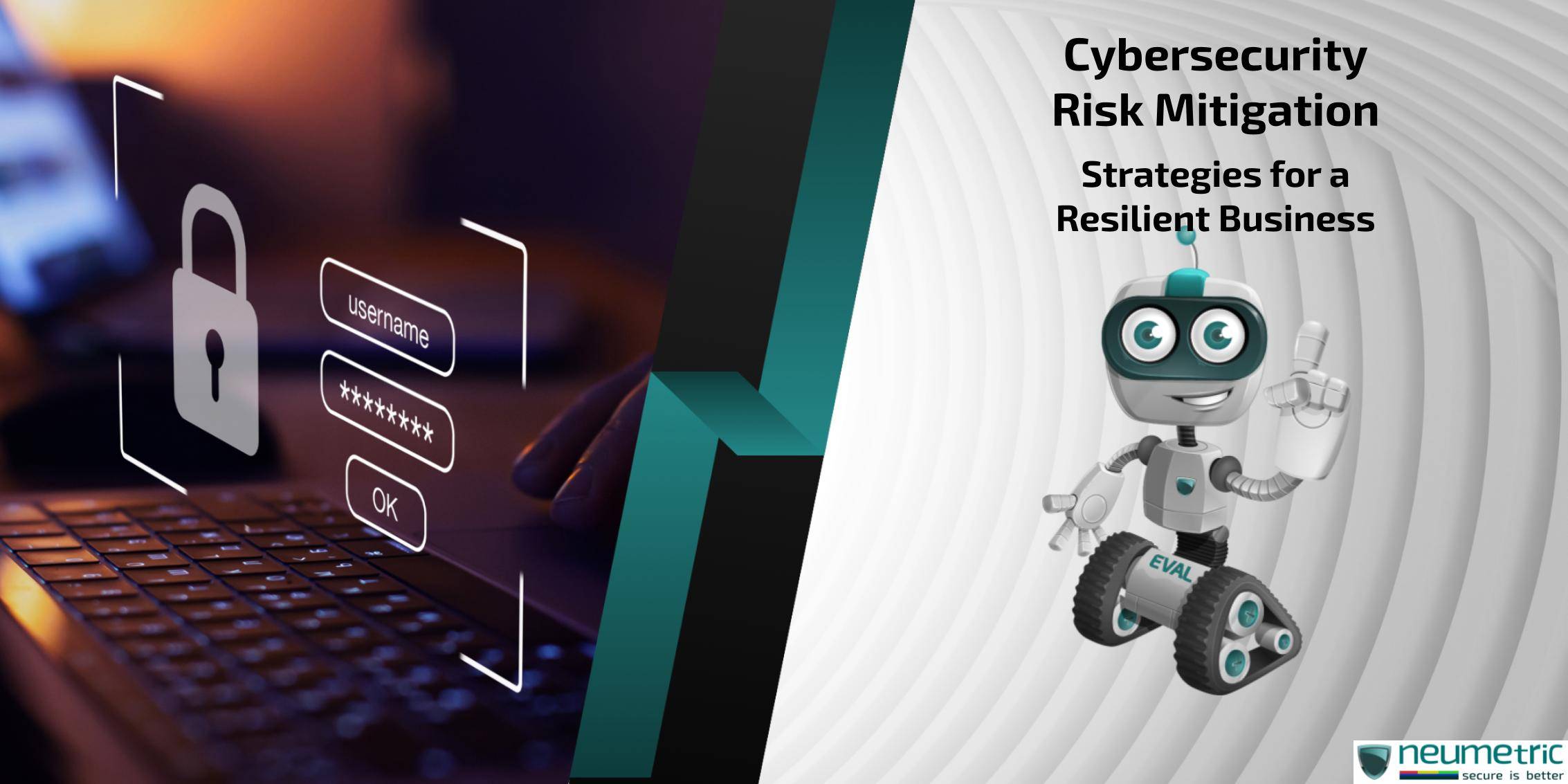Table of Contents
ToggleCybersecurity Risk Mitigation: Strategies for a Resilient Business
Introduction
Businesses in the linked digital era face an expanding & sophisticated cybersecurity threat landscape. Threats have changed due to the development of technology & the increasing sophistication of cyber attackers. The threat of cyber-attacks looms big for small businesses & huge corporations alike, spanning a wide range of dangers that can jeopardise sensitive data, disrupt operations & damage reputations.
Businesses cannot overestimate the value of cybersecurity. The potential impact of cyber threats on organisations’ operations & overall well-being grows as they become increasingly digitally dependent. Cybersecurity risk reduction is more than just a precaution; it is a strategic necessity for guaranteeing company continuity, keeping consumer trust & protecting intellectual property. Neglecting cybersecurity can have serious ramifications, ranging from financial losses to regulatory penalties & long-term damage to brand credibility.
The goal of this Journal is to delve into the complexities of cybersecurity risk reduction & provide businesses with effective ideas for fortifying their defences. The Journal seeks to provide a thorough perspective by studying the expanding threat landscape, identifying different types of cybersecurity threats & emphasising the dynamic nature of these risks. The scope includes the investigation of successful cybersecurity strategies, technology & emerging trends, which will enable enterprises to handle the challenges faced by an ever-changing cyber ecosystem.
Understanding Cybersecurity Risks
Malware & Ransomware: Malware, which includes viruses, trojans & ransomware, is harmful software that is meant to compromise systems & data. Ransomware, in particular, has grown in popularity, encrypting data & demanding payment to unlock it.
Phishing Attacks: Phishing attacks use deceptive tactics to fool people into disclosing sensitive information such as passwords or financial information. These assaults frequently target human weaknesses rather than technological problems.
Insider Threats: Insider threats involve employees, either intentionally or accidentally, compromising security. Employees, contractors, or partners with access to vital systems & data may fall into this category.
Cybersecurity threats are dynamic & ever-changing. To exploit developing vulnerabilities, threat actors modify their tactics, methods & procedures [TTPs]. Because of the interconnected nature of modern technologies, such as cloud computing & the Internet of Things [IoT], organisations must remain watchful & adjust their cybersecurity procedures accordingly. Understanding the shifting nature of cyber threats is critical for adopting proactive & effective cybersecurity risk mitigation methods as cyber attacks become more complex. Organisations must appreciate that cybersecurity is a continuous commitment to staying ahead of attackers in the ever-changing digital landscape, rather than a one-time expenditure.
Impact of Cybersecurity Incidents on Businesses
Financial Impact: Cybersecurity incidents can have significant financial consequences for enterprises. Direct costs include incident response, system restoration & legal representation. Indirect expenses, which are frequently more significant, result from business disruption, loss of productivity & potential revenue drop. Businesses may face regulatory fines & penalties in severe circumstances, increasing the financial consequences. An organisation’s long-term financial health is inextricably related to its capacity to handle & recover from cybersecurity disasters.
Reputational harm: Reputational harm is an intangible yet enormously damaging outcome of cybersecurity disasters. When a company suffers a data breach or a cyber-attack, public trust suffers. Customers, partners & stakeholders may lose faith in the organisation’s ability to protect sensitive data. Customer attrition, lower brand value & a tarnished market image are all consequences of reputational damage. To prevent such tragedies, confidence must be rebuilt by strategic communication, transparency & robust cybersecurity measures.
Legal & Compliance Implications: Cybersecurity events frequently result in legal & compliance consequences. Businesses may be liable to data protection requirements, such as GDPR or HIPAA, depending on the nature of the breach, resulting in regulatory investigations & fines. In addition, aggrieved persons may take legal action, increasing legal costs. Noncompliance with industry-specific regulations can result in significant penalties, affecting the organisation’s overall legal status & operational continuity. Navigating the complex legal landscape requires a thorough awareness of cybersecurity rules as well as proactive actions to maintain compliance.
Creating a Cybersecurity Risk Management Framework
Risk Identification & Assessment: A solid cybersecurity risk management system begins with a thorough risk assessment. Identifying potential threats & vulnerabilities, as well as estimating the impact & possibility of certain situations, are all part of this process. Businesses must understand their specific risk landscape, taking into account aspects such as industry, data sensitivity & the ever-changing threat scenario. A thorough risk assessment serves as the foundation for informed decision-making, helping companies to properly prioritise & allocate resources.
Establishing a Risk Mitigation Plan: Once risks have been identified, companies must develop a risk mitigation plan that outlines strategies for risk reduction, transfer, or acceptance. This entails putting in place security controls, protocols & technologies that are tailored to the specific risks identified. An incident response strategy, communication methods & a recovery roadmap are all part of a well-defined mitigation plan. Collaboration between the IT, legal & executive teams is critical in developing a plan that corresponds with business goals & regulatory needs.
Monitoring & Adaptation: Due to the dynamic nature of cyber threats, ongoing monitoring & adaptation are required. Real-time monitoring tools, threat intelligence feeds & regular security audits are all part of a proactive cybersecurity risk management system. Organisations can quickly change their mitigation measures by staying on top of evolving threats & vulnerabilities. Continuous improvement is essential for good cybersecurity risk management because it ensures that the framework advances in tandem with the ever-changing threat landscape.
Cybersecurity Risk Mitigation Best Practices
Employee Awareness & Training: Employees are frequently the first line of defence against cyber dangers. Regular training & awareness initiatives to educate staff about phishing attempts, social engineering strategies & the necessity of secure password procedures are examples of cybersecurity best practices. A well-informed workforce helps to have a stronger cybersecurity posture, lowering the risk of falling prey to common cyber-attack vectors.
Regular Software Updates & Patch Management: Cyber attackers target outdated software & unpatched vulnerabilities. Cybersecurity best practices include regular software updates & fast patch management. Operating systems, antivirus software & third-party apps are all included. Patching systems that are automated can speed up the process, limiting the window of opportunity for attackers to exploit known flaws.
Encryption & Data Protection Measures: Encrypting sensitive data both in transit & at rest is a fundamental cybersecurity best practice. This ensures that even if unauthorised access occurs, the data remains unintelligible without the proper decryption keys. Additionally, implementing data protection measures such as data loss prevention [DLP] tools & restricting the use of removable storage devices further enhances the security of critical information.
Incident Response & Business Continuity
Creating an Efficient Incident Response Plan
The importance of preparation in limiting the consequences of cybersecurity incidents cannot be overstated. Organisations should create & keep an incident response plan [IRP] that explains what to do in the case of a security breach. A designated incident response team, communication mechanisms & a clear escalation channel are all part of this. Simulations should be used to test the IRP’s effectiveness & highlight areas for improvement.
Ensuring Business Continuity in the Face of Cybersecurity Incidents
In the aftermath of a cybersecurity event, business continuity is vital for reducing downtime & ensuring that critical processes continue. Backup systems & data recovery procedures must be in place. A resilient business continuity strategy includes cloud-based backups, redundant systems & disaster recovery strategies. The efficacy of these measures is ensured through regular testing.
Learning from Past Incidents: Case Studies
Analysing past cybersecurity incidents, whether within the organisation or in similar industries, provides valuable insights. Case studies offer an opportunity to understand the tactics employed by attackers, the effectiveness of incident response strategies & lessons learned. By learning from the experiences of others, organisations can enhance their own cybersecurity posture & proactively address potential vulnerabilities.
Cybersecurity Technologies & Solutions
Next-Generation Firewalls & Intrusion Detection Systems: The first line of defence in a cybersecurity architecture consists of Next-Generation Firewalls [NGFW] & Intrusion Detection Systems [IDS]. NGFWs go beyond typical firewalls by including sophisticated threat detection capabilities, whereas IDS monitors network & system activity for indications of hostile behaviour. These technologies work together to detect & prevent unwanted access, suspicious behaviour & potential security breaches.
Endpoint Protection & Detection: Endpoints, such as computers & mobile devices, are common targets for cyber threats. Endpoint Protection & Detection solutions focus on securing individual devices by implementing antivirus software, anti-malware tools & behavioural analysis. This helps in detecting & neutralising threats at the endpoint level, ensuring a comprehensive defence strategy across the entire network.
Security Information & Event Management [SIEM] Systems: SIEM systems collect & analyse security data from a variety of sources within a business, such as network devices, servers & applications. SIEM systems provide a comprehensive view of an organisation’s security posture by correlating this data. They are critical in the identification of real-time threats, incident response & compliance management. SIEM technologies enable proactive monitoring, allowing organisations to respond to possible security events more quickly.
Artificial Intelligence [AI] & Machine Learning [ML] in Cybersecurity: AI & ML technologies have proven vital in the fight against cyber threats. AI & Machine Learning algorithms mine massive information for patterns, abnormalities & potential security threats. These solutions improve threat detection, automate incident response & adapt to evolving cyber threats. AI & ML contribute to a more proactive & adaptable cybersecurity strategy by predicting potential threats & detecting previously unknown weaknesses.
Collaboration & Information Sharing
Collaboration among Organizations for Cyber Threat Intelligence: Organisational collaboration is critical for staying ahead of cyber threats. Sharing threat knowledge, attack patterns & best practices is part of industry collaboration. Platforms for information sharing enable businesses to benefit from collective insights, allowing them to foresee & minimise new hazards. Collaborative approaches improve industries’ & individual sectors’ overall cybersecurity resilience.
Cybersecurity Public-private Partnerships: PPPs bring together government bodies, business organisations & sometimes academia to address cybersecurity concerns collaboratively. These collaborations promote the exchange of threat intelligence, collaborative research projects & the establishment of cybersecurity standards. PPPs are critical in fostering a collaborative ecosystem that promotes innovation, information exchange & coordinated responses to cyber threats.
Regulatory Compliance in Cybersecurity
Cybersecurity policies are intended to protect sensitive information while also ensuring the resilience of key infrastructure. Regulatory frameworks set specific standards on enterprises to protect data & systems, such as the General Data Protection Regulation [GDPR], the Health Insurance Portability & Accountability Act [HIPAA] & the Payment Card Industry Data Security Standard [PCI DSS].
Understanding the specific legislation pertaining to an organisation’s industry & geographic region is necessary for navigating compliance requirements. To fulfil regulatory standards, this entails installing protections such as data encryption, access controls & incident response plans. Compliance frameworks establish principles for safeguarding sensitive information & protecting persons’ privacy.
Non-compliance with cybersecurity regulations can result in severe consequences, including financial penalties, legal action & damage to reputation. Organisations failing to adhere to regulatory standards may face legal liabilities & sanctions. Compliance not only helps in avoiding these consequences but also demonstrates a commitment to protecting customer data & maintaining a secure operating environment.
Measuring Cybersecurity Effectiveness
Key Performance Indicators [KPIs] for Cybersecurity
- Incident Response Time: The time taken to detect & respond to a cybersecurity incident.
- Phishing Resilience Rate: Measurement of employee resistance to phishing attacks through simulations.
- Patch Compliance: Ensuring timely application of security patches to systems & software.
- Detection & Mitigation Rates: Assessing the speed & efficiency of identifying & mitigating security threats.
- User Authentication Success Rates: Monitoring successful & unsuccessful attempts, identifying potential breaches.
Regular Audits & Assessments
- Internal Audits: Assessing internal policies, procedures & system configurations for compliance & effectiveness.
- External Penetration Testing: Simulating real-world attacks to identify vulnerabilities from an external perspective.
- Compliance Audits: Ensuring adherence to industry-specific regulatory requirements.
- Security Awareness Assessments: Evaluating the effectiveness of employee training & awareness programs.
Continuous Improvement Strategies
- Post-Incident Analysis: Conducting thorough analyses of cybersecurity incidents to identify areas for improvement.
- Feedback Loops: Encouraging reporting of security concerns & creating mechanisms for continuous feedback.
- Technology Updates: Staying abreast of technological advancements to integrate the latest security solutions.
Conclusion
In summarising major techniques, it is clear that a multifaceted approach is required. Understanding cybersecurity threats, putting in place strong procedures, using sophisticated technologies, engaging with peers in the sector & adhering to regulatory compliance all work together to enhance an organisation’s defences. A resilient cybersecurity strategy is formed by the combination of proactive measures, incident response readiness & a culture of continuous development.
The increasing frequency & sophistication of cyber threats emphasises the need for organisations to invest in cybersecurity resilience. The financial, reputational & operational ramifications of cybersecurity incidents demonstrate that proactive cybersecurity investment is not an option, but rather a requirement. Because the cost of a breach far outweighs the investment necessary to strengthen defences, cybersecurity resilience has become a strategic necessity for long-term viability.
Looking ahead, the future of cybersecurity presents both challenges & opportunities. Challenges include the evolution of attack vectors, the integration of emerging technologies & the need for skilled cybersecurity professionals. Opportunities lie in the advancement of AI & ML technologies, increased collaboration in threat intelligence sharing & the development of more robust cybersecurity regulations. Businesses that anticipate & adapt to these dynamics position themselves to not only withstand future challenges but also capitalise on the opportunities presented by an ever-evolving digital landscape.
FAQ’s
What are common cybersecurity KPIs?
Common cybersecurity Key Performance Indicators [KPIs] include incident response time, phishing resilience rate, patch compliance, detection & mitigation rates & user authentication success rates.
How can businesses achieve continuous improvement in cybersecurity?
Continuous improvement in cybersecurity involves post-incident analysis, feedback loops for reporting security concerns, staying updated on technological advancements, adaptive training programs & conducting regular incident response drills.
Why is urgency emphasised for businesses to invest in cybersecurity resilience?
The urgency stems from the increasing frequency & sophistication of cyber threats, with the cost of a potential breach far exceeding the investment required to fortify cybersecurity defences.





